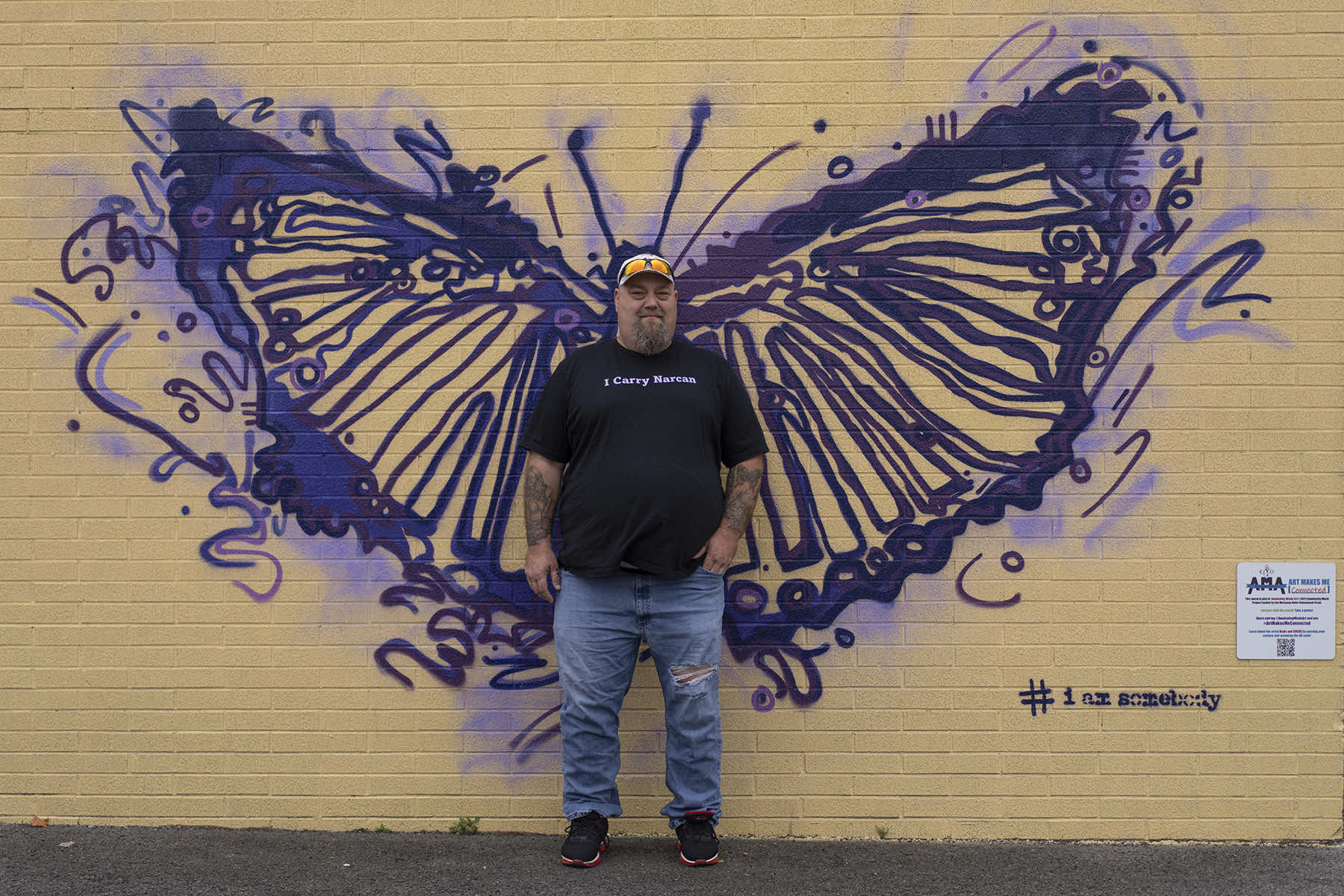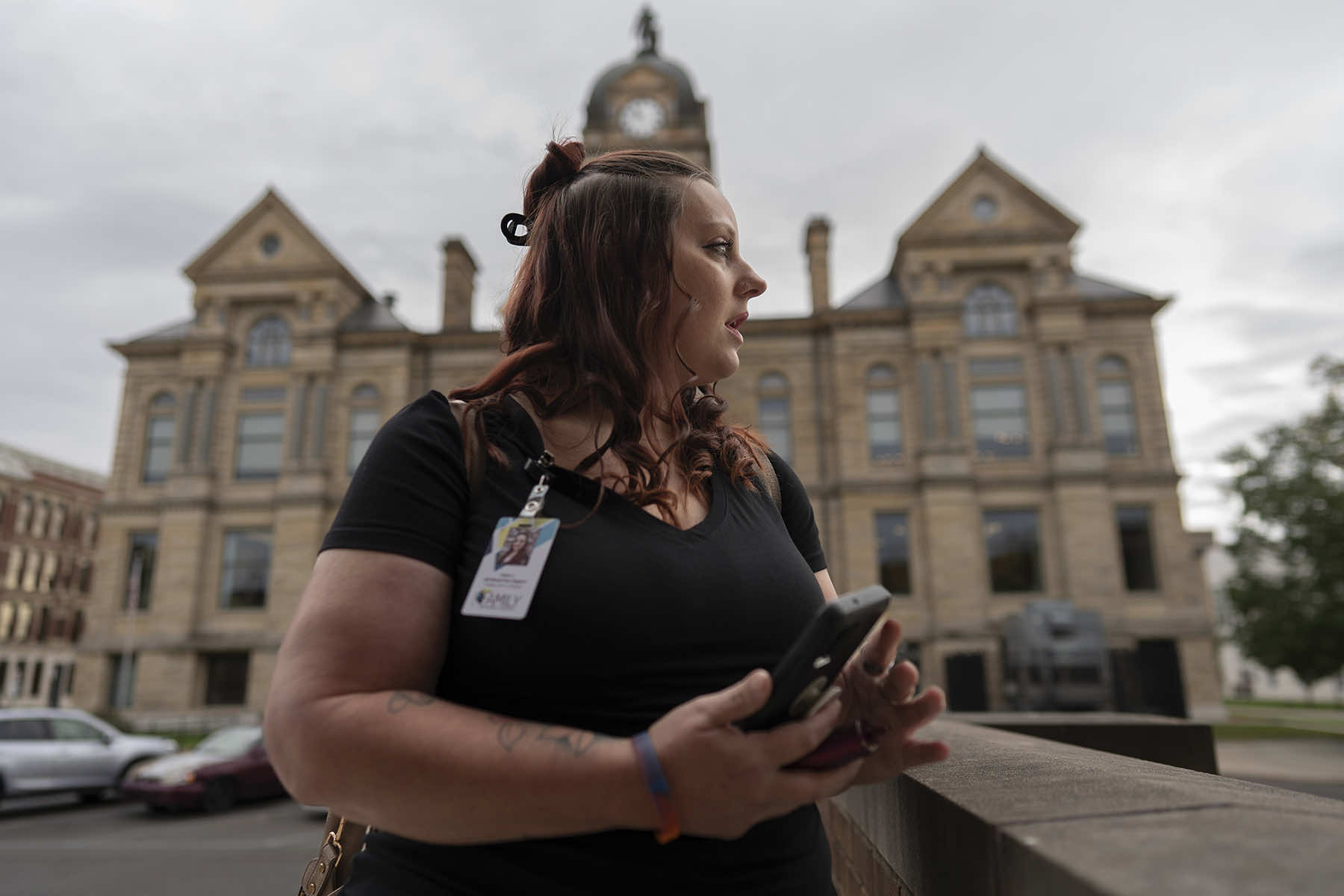
Communities ravaged by America’s opioid epidemic are starting to get their share of a $50 billion pie from legal settlements. Most of that money comes with a requirement that it be used to address the overdose crisis and prevent more deaths. But how?
It could mean that places look more like the area around Findlay. Here, conservative Hancock County has built a comprehensive system focused on both treatment and recovery by adding housing, a needle exchange, outreach workers and a community center.
“People recover in a community,” said Precia Stuby, the official who heads the county’s addiction and mental health efforts. “We have to build recovery-oriented communities that support individuals.”
* * *
It was 2007 when Stuby began hearing from officials about prescription opioids being misused. That was about the same time Jesse Johnson, then 14, was prescribed the painkiller Percocet.
The Findlay native was pregnant when she needed stents put into her kidneys as treatment for infections and kidney stones. After seven months on the opioid medication, she gave birth to a healthy daughter. Then she underwent an operation to remove the stents. The prescriptions stopped and she became sick from withdrawal.
“I remember not even being able to hold my daughter,” said Johnson, now 31. “It just hurt.”
Alcohol, marijuana and, a few years later, cocaine and opioids from the black market helped Johnson ease the pain.
By then, county officials were seeing the area’s fatal opioid overdose toll tick up. The recovery system then included only some outpatient services and Alcoholics Anonymous.
“We were grossly underprepared, like I think many places across the country were, for the opioid epidemic,” Stuby said.
From 1999 through 2020, 131 deaths in the county were attributed to opioids. Across the country, it was more than 500,000. The county’s opioid-linked death rate over that period paralleled the nation’s.
But the county took a path that many places did not.
Officials created a plan with the help of the federally funded Addiction Technology Transfer Center that stressed recovery and built upon a local recognition that “this is our family, our friends, our brothers, our sisters,” Stuby said.
A lot of the pieces of the county’s transformation, including aggressive outreach to people who had overdosed, were in place nearly four years ago, when an overdose put Johnson at the edge of death. By then, the crisis had shifted from prescription painkillers to heroin and then to even more potent fentanyl, an opioid produced cheaply in illicit labs.
Her mother was told to prepare for a funeral.
Johnson, then 27, survived. But when she was well enough to leave the hospital, her mother didn’t let her come home. Instead, she went to Findlay’s homeless shelter. She had just hospital scrubs to wear.
There, a peer support worker — someone in recovery herself — tracked her down.
“The person who was trying to find me didn’t give up,” Johnson said. “She took me under her arm and carried me through some of the hardest weeks that I would have.”
* * *
The settlement funds from drugmakers, wholesalers and pharmacies will not be enough for every harm reduction, treatment, recovery and prevention program that might be needed to fight the nation’s opioid epidemic.
But it could be enough to jumpstart major changes to the efforts.
Since its implementation began a decade ago, Hancock County has brought in more than $19 million in grants, largely from the federal government. Other funding comes from a county tax levy and the state. Health insurance helps pay for treatment.
Like hundreds of U.S. communities, it’s launched a drug court where people can avoid jail if they work on recovery. At a recent session in the county’s historic courthouse, applause rang out as one woman advanced toward graduation. The judge also ordered an immediate drug test to determine whether one man could continue in the program.
Some advocates urge communities not to spend settlement funds on drug courts, saying there’s limited evidence they work and that participants who return to drugs can end up with harsh jail sentences.
Kerri Kostic, who had been using drugs for 30 years, said drug court helped her stop using.
“It was just an endless, ridiculous, awful cycle,” said Kostic, now a peer support worker in a neighboring county. “Thank God I went to drug court here in Hancock County.”
At Stuby’s urging, the University of Findlay launched classes on addiction. They can lead to an entry-level certificate for work in the field — a partial answer to a recovery workforce crunch.
There are three recovery homes and a community center where people can attend 12-step meetings, play video games or learn to crochet — and a similar place for teens.
Hancock’s network amounts to a “no wrong-door” system, said Meelee Kim, a Brandeis University social scientist who evaluates some of the county’s federal grants. Someone showing up at the recovery center can be connected in a “warm handoff” to a treatment provider because of personal connections between the programs.
The idea, which echoes experts’ recommendations for use of the settlement money, is that people with the right support can recover from addiction. Every person who stays in recovery is a person who will not die of an overdose.
“It’s not just about how to get people off of opioids, but how do we keep them in remission and increase their stable recovery?” said John F. Kelly, of Harvard Medical School. His research has shown that recovery support services — such as housing, community centers and peer coaching — can help.
“That’s something to be optimistic about, for families to not give up hope that their loved one will be able to get and stay in remission,” he said.
* * *
The first step is keeping people who use drugs alive using practices known collectively as harm reduction.
There’s evidence that the efforts are helping. After 28 overdose deaths from all drugs last year, Hancock County has three confirmed overdose deaths and five suspected ones so far in 2023.
The county launched a needle exchange, providing supplies to reduce needle sharing and the risk of HIV and hepatitis C. These are policy staples in larger cities, but less common in smaller ones, in part because critics worry they enable illegal and unsafe behavior.
Earlier this year, the staff added safe smoking supplies so people who smoke drugs can avoid burns and the release of toxic fumes. But it agreed to stop after city officials objected.
Other harm reduction measures in Hancock County include distributing naloxone, a drug that can reverse overdoses, and strips to test drugs for the powerful opioid fentanyl and for xylazine, a veterinary tranquilizer that can slow the nervous system and cause wounds that can become infected.
Stuby said she would like to send people released from jail home with naloxone, but that law enforcement officials haven’t been willing to go that far.
Instead, distributing the opioid antidote happens elsewhere.
At the Family Resource Center, the quick response team compiles lists of overdose survivors and people with substance use disorder who are being released from jail or prison.
One afternoon, Misty Weaver, the team coordinator, went out to check on two recent overdose survivors. One who overdosed in a Walmart parking lot gave a home address that didn’t exist. The person who answered the door for the other said the man had gone to a rehab facility. Weaver left a bag full of materials, including socks, naloxone, test strips, condoms and information about other services.
* * *
Christina McCarver, then living in Toledo, did a 30-day treatment program to address her opioid addiction. Within 24 hours of being released, she relapsed and returned to the treatment center.
The center found a place for her in its Findlay facility. After that program, she moved into a room at the women’s recovery home. It turned out to be an important part of her recovery.
“We keep each other in check,” she said. Instead of talking about drugs with “using friends,” she said, “we kind of do it the other way, where we talk ourselves into, ‘Let’s go to a meeting instead.'”
For the 49-year-old McCarver, who’s survived a half-dozen overdoses in a life rife with trauma, being in the house made her feel like she was trusted and needed again.
After eight months living there, McCarver became the on-staff coordinator for the house. After three years with that job, she recently moved to a similar position at the home for mothers.
The homes, in residential neighborhoods, require people to be in recovery for 30 days before moving in. Rules include doing jobs around the house, attending mandatory meetings and events — and drug test requirements.
In the men’s house, William Mull appreciates having structure and a mentor, Cory Kinn, who’s a few years further along in recovery.
“That’s always better than having someone who’s just trying to tell you something they’ve read out of a book,” said Mull, 38.
When the first home was planned in 2015, it faced strong community opposition.
After that, Stuby said she increased her efforts to keep Findlay officials and the public in the loop. The newer homes haven’t caused a stir.
Kinn, a former construction worker who got into recovery work after a stint in jail on a drug conviction, spends his nights as the live-in coordinator at the men’s recovery house and his days working with clients involved in the criminal justice system.
Even early in his recovery, he said, he didn’t care if he stayed alive. Now? “I’ve built a life that I don’t have to escape from.”
The community could use more recovery housing, he and others say.
And it’s hard for clients to get to probation meetings, medical appointments, 12-step meetings and other places they need to be. In a spread-out community with no bus system, getting around is an issue for people who don’t have cars or aren’t allowed to drive.
If they call someone they know for a ride, it could be “the dope man” or drug dealer, he said.
* * *
In November 2021, when Jesse Johnson was about a year into recovery, her mother let her come to her home for double festivities: Thanksgiving and her daughter’s birthday.
The next day, Johnson said, her mother was in a hospital with COVID-19. She died within weeks.
It was a stressful period, but Johnson did not return to using drugs.
“I still sometimes wonder how I didn’t turn back to what I knew best,” Johnson said.
Instead, she’s persevered and has relationships she thought she never would: Her 16-year-old daughter and 2-year-old son live with her, and she often sees her two other sons, who live with her stepfather.
Earlier this year, she started a job with the Family Resource Center, the same organization that employed the peer support worker who was so instrumental in her own early recovery. She’s working with jail inmates and people on the outside.
“It’s something that I’ve always wanted to do,” she said, “because I wanted to be that person that reached out to me and then found me at one of the worst times in my life and pulled me together somehow.”















